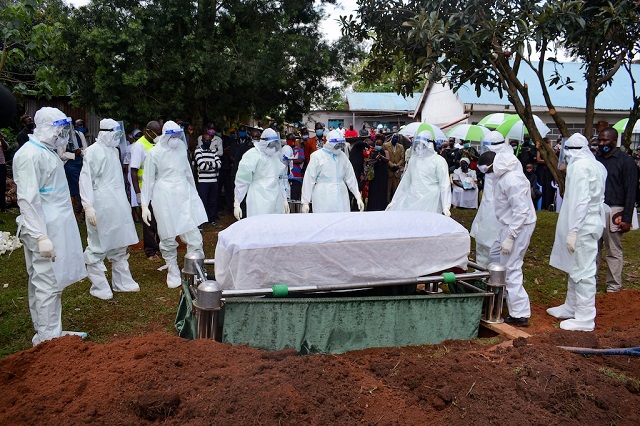
Pressure from business, politics
That the Ministry of Health is warning of a growing COVID-19 catastrophe while the government is further lifting lockdown restriction may appear like a contradiction but it is not.
After months of various forms of restrictions imposed since COVID-19 first emerged in Wuhan around November 30, 2019, many countries are lifting them. Many countries are easing restrictions after flattening the curve of new infections. But many, like Uganda, do it at a time rising new infections in the community. In this case, scientists warn of danger ahead.
South Africa which has had the most infections on the continent and imposed a national lockdown on March 27 has been easing restriction even if its numbers remain high. Its curve appears to have peaked.
By Sept. 16 it had reported more than 653,444 confirmed infections, with over 15,705 deaths but the number of new cases was dropping; from about 12,000 per day in July to fewer than 2,000 in September.
South Africa’s President, Cyril Ramaphosa, was at the time announcing the opening of schools, gyms, and theatres, and lifting of restriction on social, religious, political and other gatherings, permitting travel in and out of the country on Oct.01, allowing gathering of 250 people indoors and 500 outdoors and easing night curfew.
Nigeria which is the third most hit country in Africa had by Sept.17 recorded 56,604 confirmed cases and 1,091 deaths. The rate of new daily infections declined from a high of 566 on June 29 to 126 on Sept.16.
Nigeria imposed restriction on major urban centres on March 30 but had been easing restrictions since April even as cases of new infections were rising. But President Muhammadu Buhari in August extended a nationwide lockdown for four weeks after daily cases again jumped from 304 of Aug.02 to 602 on Aug.26.
Many countries are opening up because sub-Saharan Africa has not seen the extreme numbers of COVID-19 infection rates and deaths seen elsewhere.
The re-opening appears to be driven by pressure from the public for return to normal for social, economic and political reasons.
“There can’t be livelihood without life and there can’t be life without livelihood,” famously twitted Norbert Mao, the leader of the opposition Democratic Party (DP), “Let’s talk about livelihood of our people with or without corona virus. We can’t keep hiding from corona virus forever. Ease the lockdown.”
Push for herd immunity
But there are also scientists pushing for lifting of lockdown restriction so that the community can acquire the so-called “herd immunity.”
These scientists note that in a completely susceptible population, COVID-19 spreads rapidly in an unchecked manner following sufficient exposure to infected persons. But if immunity exists among a significant proportion of the population, the likelihood of transmission of the pathogen will be reduced. That is the herd immunity onset.
It is defined as the level at which the proportion of susceptible individuals falls below the required threshold for transmission of the virus. It is what vaccination programmes aim for. Some scientists say herd immunity contributed to the sharp decline in the spread of the Zika virus that struck South and Central America and the Caribbean in 2015-16 causing more than half a million suspected cases and more than 3,700 congenital birth defects.
Many scientists believe herd immunity can stop COVID-19. They propose a strategy to expose all persons to the Coronavirus, which in turn increases the population herd immunity to COVID-19. However, some scientists warn that pursuing herd immunity may come at a high cost in number of deaths of infected persons.
So the question often posed is: How many deaths would have to occur by the time herd immunity is achieved?
To answer that question, scientists build mathematical models.
First, they look around for the number of secondary infections introduced by a single infectious individual; the basic reproduction number (R0) of the virus in that particular population.
The Coronavirus has been estimated right from its onset to have a basic reproduction number (R0) between 2 and 6, with differing values across countries. It depends on variation of the transmission dynamics caused by population structure, its density, and contact rates. Then the scientists look at another factor related to the coronavirus; its case fatality rate (CFR).
The CFR considers the cumulative number of confirmed death as a percentage of the confirmed cases of COVID-19 infections based on credible sources; such as the Uganda National Bureau of Statistics (UBOS).
In the study, Nigeria which has a population of 201 million according to the world population bureau, had as at June 4, 2020 recorded 11,166 cases of COVID-19 and 315 deaths. Its case fatality rate (CFR) was, therefore, 2.8%. The scientists calculated that Nigeria had a COVID-19 basic reproductive number of 3 and a corresponding herd immunity of 67%.
Based on the scientific calculations, that meant that for Nigeria to get herd immunity 67% of its population or 134.7 million people will have to be infected. Of these, 2.8% or 3.8 million people would have to die.
The scientists also looked at Cape Verde, which has a very low population of just 500,000 people and at the time had just 477 cases of COVID-19, five deaths, and a CFR of 1.1%. To have herd immunity to COVID-19 in Cape Verde 402, 000 person would have to be infected and 4,422 deaths.
The scientists concluded that based on an overall CFR of COVID-19 of 2% in West Africa, 5.2 million people would have to die before the region attains herd immunity.
 The Independent Uganda: You get the Truth we Pay the Price
The Independent Uganda: You get the Truth we Pay the Price



